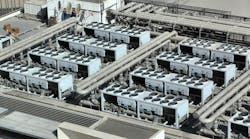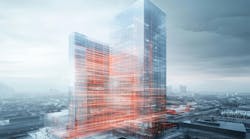Applying Operational Effectiveness Lessons to Enhance BMS Performance
Efficiency is one of the key metrics often used to assess the performance of a building management system (BMS), but many may not have considered effectiveness first. Traditionally, there has been an over-focus on driving efficiency, which can actually cause more problems from systems, usage, and cost perspectives. From an operational standpoint, gaining measurable improvement requires an approach that values system effectiveness before moving to efficiency. Operational effectiveness (OE) weighs how systems achieve a specific goal while applying continuous learning and improvement to meet variable factors.
While OE is a familiar concept within the manufacturing space, the buildings industry could benefit from adopting an OE mindset to reduce waste, lower costs, and improve equipment lifespan. Applying an OE framework is vital for ensuring that a system continuously achieves its goals on a day-to-day basis. Once this is met, systems can pursue efficiency goals to reduce resource consumption.
This approach contrasts with the current state where systems are installed and configured, then optimized for efficiency while taking for granted the continuous monitoring needed to ensure ongoing adherence to defined system goals. Recent research into how commercial buildings can enhance refrigeration equipment operations revealed many ways OE could be applied to other building systems.
For example, industrial refrigerators must maintain a particular temperature for safety like those used in pharmacies, hospitals, or supermarkets. This equipment runs 24 hours a day, often storing tons of perishable items across vast spaces, and there is little margin for error. Reliability is a critical factor in these operations. If a retailer notices their fridge isn’t maintaining its set temperature effectively, a technician focused on operational effectiveness will first identify the root cause, such as low refrigerant charge or doors not sealing correctly. Without considering OE, operators may infer that the refrigerator is over capacity, setting off a cascade of unnecessary expenses, where a different approach could better solve the issue. Considering how the equipment will operate in real-life scenarios is critical to ensure system operations achieve their primary goals.
The lesson for facilities managers is that while efficiency goals should be set, it’s vital to ensure how systems deliver on their predetermined operational goals. If a system is not performing as expected, focusing on efficiency doesn’t matter. While energy efficiency is essential, if it conflicts with the day-to-day usage of a system, it is not operating effectively. For example, energy management is a vital component in building operations. A reactive BMS that integrates with the HVAC system and can continually monitor an environment, analyze data, and adjust settings will use energy most efficiently while ensuring occupants are also comfortable. However, if the constituent components of the system are not optimally tuned for their task, with each able to deliver high operational effectiveness, the BMS system will struggle to meet its overall goals.
In modern commercial buildings, spaces are highly dynamic and constantly changing in usage. Sometimes, offices and even whole floors are empty; other times, customers and employees pack these spaces. If energy efficiency is the sole focus, then the most efficient way to reduce energy use in an office would be to keep the thermostat at the lowest setting or even off at all times year-round. However, occupants would not appreciate this choice when it’s cold outside.
In this situation, the most effective use of energy allocation is deciding how the building’s climate control, lighting, and air purification systems should operate in a particular space while people use it. Many factors can be measured: the number of occupants, the size of the space, external temperatures and humidity levels, and even the number of or lack of windows. A building system that can autonomously respond to variations and adjust the lighting and HVAC equipment to maintain a desired outcome delivers both effectiveness and efficiency. A system that can continuously compile and analyze relevant data to calculate and manage OE goals will more swiftly adapt to changing conditions and meet goals.
Attention to these details applies to building system equipment maintenance cycles. Equipment that is properly maintained will function more efficiently with fewer breakdowns. However, overservicing equipment strictly by the calendar means higher labor expenses. When a BMS continually measures performance, it will detect anomalies earlier to avoid expensive breakdowns and downtime.
Installing systems with sufficient data collection and monitoring capabilities to track and utilize OE measures will ensure effective operation throughout modern built environments' highly variable usage patterns. Intelligent tools that operate under an “edge with cloud” framework can boost hardware and software functionality to support these goals. Rather than approaching the edge and cloud as two siloed processing centers, a unified approach will bring more insights with its ability to enhance cloud and device processing capabilities. A holistic strategy that integrates continual measurement and real-time responses will help building managers meet both their efficiency and effectiveness goals.


